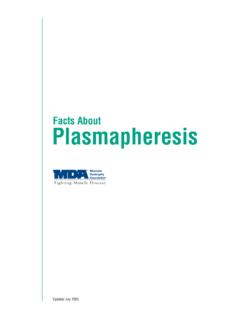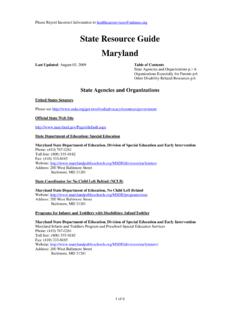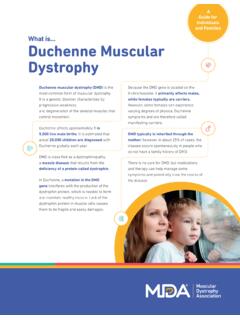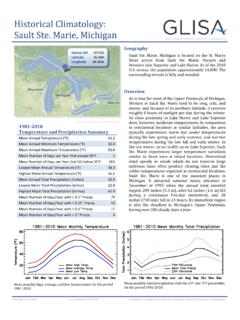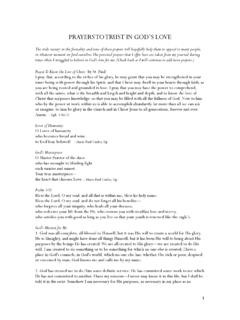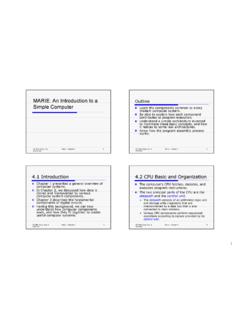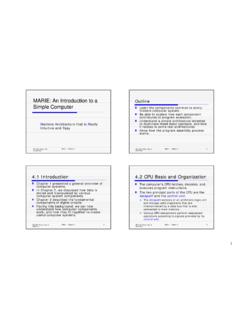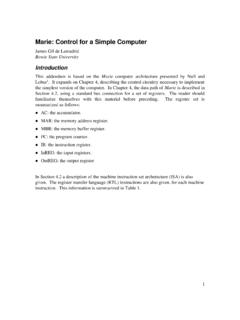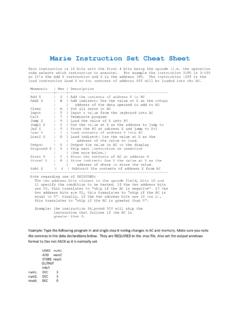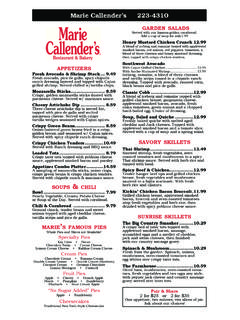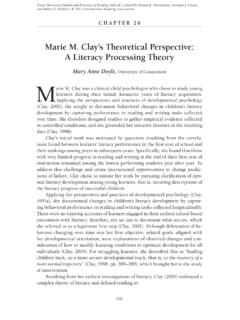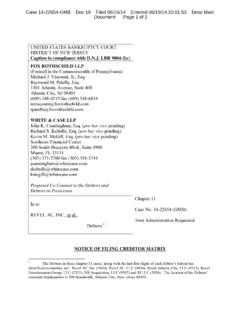Transcription of Charcot-Marie-Tooth Disease - mda.org
1 2011, No. 322 Questby Margaret WahlIt begins with weakness in the mus-cles of the lower legs and feet, caus-ing frequent tripping and ankle injuries. Feet are often so high-arched that com-fortable shoes can t be found. Hands also can be affected, making it difficult to hold a pencil, type on a computer or play a musical of sensation in the lower legs, feet, hands and forearms often occurs. Although not as troublesome as weak-ness in these areas, it can make simple tasks more problem underlying all these signs and symptoms is Charcot-Marie-Tooth Disease , or CMT, named after the three physicians who first described it late in the 19th century: Jean-Martin charcot and Pierre Marie, two French neurologists, and British physician Howard Henry generally begin in child-hood or adolescence, although onset can be as early as infancy or as late as adulthood.
2 The Disease is usually slowly progressive, with the majority of patients able to function without severe disability albeit with some difficul-ties all their , CMT comes with a family history. When multiple family members are affected, the symptoms, though they re not generally welcome, at least are recognized and there s no family history of CMT, children displaying symptoms ini-tially may be warned to stop dragging your feet or pay attention to what you re doing, or they may be treated for conditions they don t diagnostic procedures, better data collection, a new clinical trials network and new laboratory research are the foundations of MDA s CMT programA problem in the peripheral nervesCMT is a genetic problem in the periph-eral nerves bundles of fibers (also called axons)
3 That run between the spinal cord and brain and the periphery of the body. Peripheral nerves transmit signals from the brain and spinal cord out to the muscles, making movement pos-sible; and back from the periphery of the body to the spinal cord and brain, allowing sensations to be the early 1990s, defects that can cause CMT have been identified in more than 30 genes, improving diagno-sis and understanding of the underlying molecular mechanisms. The genes involved (many of which were identified by MDA-supported researchers) carry instructions for proteins that affect various aspects of peripheral-nerve most of the various types of CMT, the primary problem lies in one of three places: in the axon itself; in a sheath made of myelin (a mixture of proteins and fats) that surrounds each axon; or in the cells known as Schwann cells that lie along the surface of each axon and make this myelin myelin made by the Schwann cells winds around the axon the way paper towels wind around a cardboard tube.
4 Among other functions, the myelin sheath insulates the axon and speeds nerve conduction along its length, just as insulation aids signal transmission through a peripheral nerves (green) are bundles of nerve fibers that transmit signals to and from the spinal cord and brain (red).A high-arched foot is typical in anything is amiss with the axon or its myelin sheath, motor and sensory signals can t be effectively transmitted, especially over long distances such as between the spinal cord and the feet or In Focus: Charcot-Marie-Tooth Disease 2011 MDAC harcot-Marie- tooth DiseaseIn Focus2011, No. 3 23 QuestSorting Out CMTA useful but unwieldy CMT classification system helps make sense of the many subtypes of the diseaseby Margaret WahlAs recently as the early 1990s, many experts hoped that understanding just a few genes that influenced the development or maintenance of myelin or axons (see graphic, left) would explain all of Charcot-Marie-Tooth didn t turn out to be that simple, however.
5 Today, there are dozens of genes recognized that, when flawed, can cause CMT-related genetic muta-tions cause defects or abnormal levels of proteins in the myelin sheath. Other CMT mutations directly affect proteins in the axon. Still other flaws have complex, indirect effects on myelin, axons or the interactions between the currently used classification sys-tem for CMT is based on two criteria: whether it s primarily the myelin or the axon that s affected; and how the Disease is inherited. In broad strokes, CMT is divided into types 1, 2 and 4. (For complex rea-sons, type 3 no longer exists as a type of CMT.)
6 Types 1, 2 and 4 are further divided into subtypes based on specific genetic forms of the diseases are some-times called Dejerine-Sottas types 1 and 2 Type 1 are the problems where there s abnormal myelin; in type 2, the myelin is Moving from supportive care toward Disease - modifying therapiesMDA has been funding CMT research since the 1960s. As of the end of 2010, MDA had awarded more than $ mil-lion to investigators in this Disease and is currently supporting 22 CMT-related research , medical care for CMT remains mostly supportive, consisting largely of bracing and surgery for the feet. (See Surgery Sometimes, Bracing Supportive shoes and lower-leg braces are helpful to many with , Caution Always: Caring for the CMT-Affected Foot, in the September 2006 issue of Quest.)
7 Doctors and scientists gathering data from human and laboratory studies are rapidly adding pieces to the CMT puzzle. Research in CMT-related biology has allowed doctors to know more than ever about how nerve fibers work in health and dis-ease, providing vital clues for devel-opment of new therapies (see CMT Science Today, page 6).In addition, a new partnership between MDA and the National Institutes of Health (NIH) has led to an international network of cen-ters to assess people with CMT and collect data, forming a crucial infrastructure on which to base future trials of new treatments. (See Providing a Network for Clinical Research in CMT, page 4.)
8 Today, the speed and accuracy of CMT diagnosis has improved markedly from just a few years ago; and Disease -modifying drugs, while not yet available, probably aren t far following pages present information about the latest in CMT diagnosis, research and clinical trials. For answers to specific ques-tions about your own CMT diagno-sis, talk with your MDA clinic team. Axons, which are attached to nerve-cell bodies, can be covered with a sheath called myelin, which is made by Schwann cells. The Schwann cells lie along the axon, and the myelin sheath wraps itself around the axon as it , the speed and accuracy of CMT diagnosis has improved markedly from just a few years ago; and Disease -modifying drugs, while not yet available, probably aren t far In Focus: Charcot-Marie-Tooth Disease 2011 MDA2011, No.
9 324 Questa series of flow charts for physicians to follow that can drastically reduce the cost of CMT genetic testing by reduc-ing the number of genes that need to be paper on the subject was pub-lished online Jan. 28, 2011, in Annals of Neurology. (See and also Flow charts will aid CMT diagnosis in Research Updates in the April-June 2011 Quest.)The investigators found that the most common types of CMT, in order, were CMT1A, CMT1X, CMT1B and Diagnostics ( ), a commercial testing laboratory in Worcester, Mass., offers DNA analysis of some 15 CMT-related genes. Other labo-ratories that offer various types of CMT genetic testing can be found through Gene Tests ( ), a listing overseen by the National Institutes of Health and spon-sored by the University of and genetic counselors associated with MDA clinics can help locate and interpret genetic tests for CMT, as well as offer advice on how to focus testing to reduce do genetic testing for CMT?
10 When asked about genetic testing in CMT, Shy says, This is the patient s decision, not the doctor s. There are pros and cons; it depends on the person. That said, he thinks there are some benefits to genetic testing beyond intel-lectual curiosity or research applications. Once you find the gene, you can get a handle on what the natural history of the Disease might be and also the inheri-tance pattern, Shy says. For example, family histories may look the same for people with CMT due to a new, dominant mutation and for those with CMT caused by inheriting two recessive mutations, but there s a big classification system gets a bit unwieldy, Shy explains, because it reflects a combination of causation (myelin versus axonal damage) and inheritance pattern.

